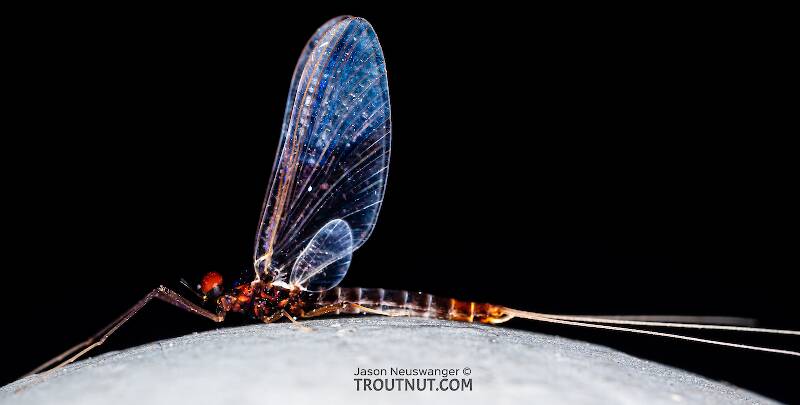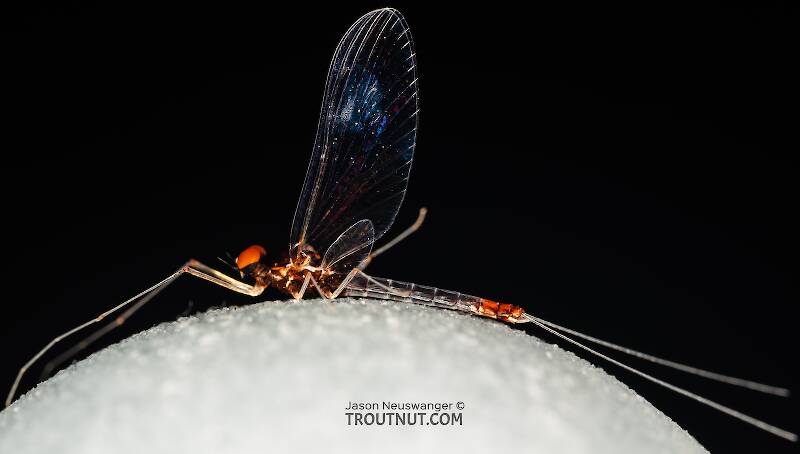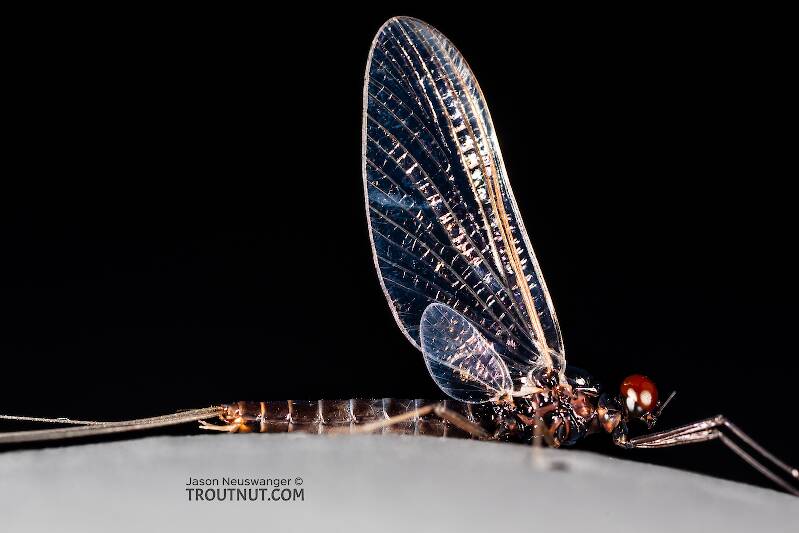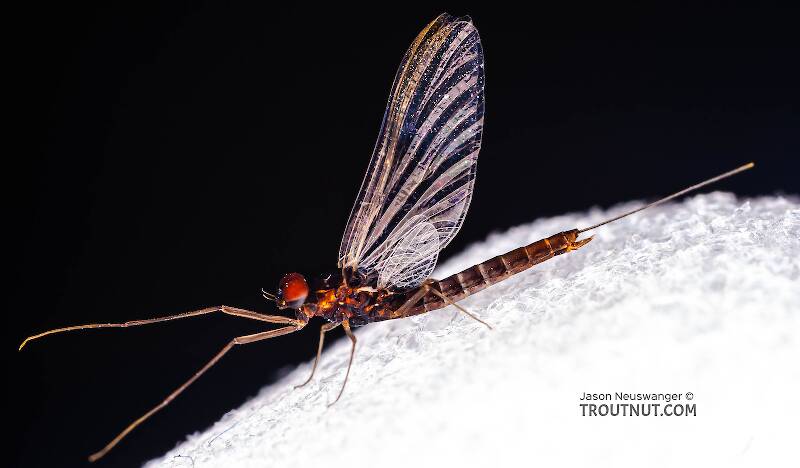
Blue-winged Olives
Baetis
Tiny Baetis mayflies are perhaps the most commonly encountered and imitated by anglers on all American trout streams due to their great abundance, widespread distribution, and trout-friendly emergence habits.
Featured on the forum

This seems to be a young larva of Limnephilus. Although not clear in the picture, several ventral abdominal segments have chloride epithelia.

Troutnut is a project started in 2003 by salmonid ecologist Jason "Troutnut" Neuswanger to help anglers and
fly tyers unabashedly embrace the entomological side of the sport. Learn more about Troutnut or
support the project for an enhanced experience here.
Identification: Key to Genera of Male Leptophlebiidae Spinners
Identification: Key to Genera of Male Leptophlebiidae Spinners
Error: Tried to access a key that isn't live.
Adapted from Merritt R.W., Cummins, K.W., and Berg, M.B. (2019)
| Option 1 | Option 2 |
|---|---|
| Hind wings without costal projections | Hind wings with distinct costal projections |
| Includes every genus commonly found and discussed by anglers | Relatively rare genera |
| Remaining genera: Leptophlebia, Neoleptophlebia, and Paraleptophlebia | Remaining genera: Choroterpes, Farrodes, Habrophlebia, Habrophlebiodes, Hydrosmilodon, Neochoroterpes, Thraulodes, and Traverella |
5 Example Specimens | |
| Go to Couplet 2 | Go to Couplet 4 |
Adapted from Merritt R.W., Cummins, K.W., and Berg, M.B. (2019)
The current couplet is highlighted with darker colors and a icon, and couplets leading to this point have a icon.
Couplet 1 (You are here)
Leads to Couplet 2:
- Hind wings without costal projections
- Includes every genus commonly found and discussed by anglers
Couplet 2
Leads to Couplet 4:
- Hind wings with distinct costal projections
- Relatively rare genera
Couplet 4
Leads to Leptophlebia:
- Middle tail often shorter and thinner than outer ones
- Hind wings usually relatively large, about 1/3 the length of forewings
- Male penes with long, decurrent appendages (source figs 13.229, 13.230)
Leads to Couplet 3:
- All tails similar to each other
- Hind wings usually relatively small, about 1/4 the length of forewings
- Male penes variable (source figs 13.281--13.283)
Couplet 3
Leads to Paraleptophlebia:
- Male genitalia with at least one pair of appendages that arise from ventral apices of penes and are more or less directed toward their fused base (source fig 13.281)
Leads to Neoleptophlebia:
- Male genitalia with a wide range of apical appendages or processes that may stick out from the apices of penes (source fig 13.282-13.283), but none that are distinctly directed toward their fused base
Leads to Habrophlebiodes:
- Costal projections of hind wings in distal half of wing margin (source fig 13.232)
- Uncommon
Leads to Couplet 5:
- Costal projections of hind wings near the midpoint of wing margin (source figs 13.231, 13.236-13.238)
Couplet 5
Leads to Habrophlebia:
- Vein Sc of hind wings extends well beyond costal projection (source fig 13.231)
- Uncommon
Leads to Couplet 6:
- Vein Sc of hind wing ends at or slightly beyond the costal projection (source figs 13.236-13.238)
Couplet 6
Leads to Thraulodes:
- Vein MP of hind wings forked (source fig 13.238)
- Uncommon
Leads to Couplet 7:
- Vein MP of hind wings simple, unforked (source figs 13.236, 13.237)
Couplet 7
Leads to Couplet 8:
- Costal projections of hind wings rounded (source fig 13.236)
Couplet 8
Leads to Couplet 10:
- Costal projections of hind wings acute (source figs 13.237, 13.269)
Couplet 10
Leads to Couplet 9:
- Vein MP2 of forewings directly connected to vein MP1 (source figs 13.234, 13.235)
- Posterior margin of female subanal plate with a shallow median indentation
Couplet 9
Leads to Neochoroterpes:
- Vein MP2 of forewings not directly connected to vein MP1
- Posterior margin of female subanal plate with distinctive deep median indentation
Leads to Choroterpes:
- Vein Sc of hind wings straight where it meets the wing margin beyond base of costal projections (source fig 13.234)
- Costal projections without small rounded apical lobe
Choroterpes
Leads to Hydrosmilodon:
- Vein Sc of hind wings curved where it meets wing margin at base of costal projections (source fig 13.235)
- Costal projections with small rounded apical lobe (source fig 13.235)
Hydrosmilodon
Leads to Traverella:
- Hind wings with at least 8 longitudinal veins and at least 12 crossveins (source fig 13.237)
- Male penes with a thin process arising near apex of each lobe and with tips directed inward and down toward fused base
Leads to Farrodes:
- Hind wings with 7 or fewer longitudinal veins and about 3 crossveins (source fig 13.269)
- Male penes with short lateral process near apex of each lobe (source fig 13.271)
Farrodes
Start a Discussion of this Couplet
References
- Merritt R.W., Cummins, K.W., and Berg, M.B. 2019. An Introduction to the Aquatic Insects of North America (Fifth Edition). Kendall/Hunt Publishing Company.






